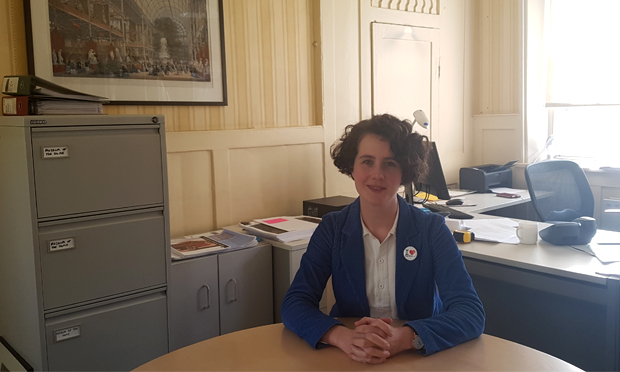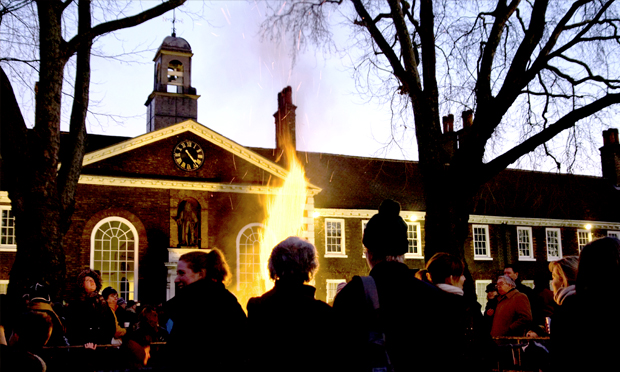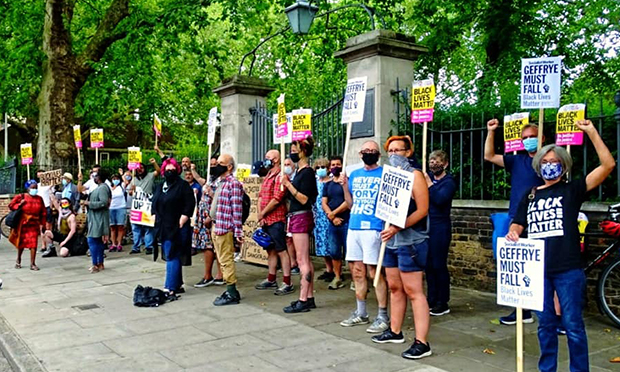Museum of the Home felt ‘extremely compromised’ by Whitehall pressure to keep slaver statue, director tells MPs

The director of the Museum of the Home (MOTH), which was the subject of government lobbying to retain the statue of slaver Robert Geffrye on the front of its building, told a gathering of MPs this week that her institution “should ideally be free to act with integrity and to act in the best interests of its beneficiaries”.
The revelation that culture secretary Oliver Dowden had written to MOTH reminding it of its status as a government-funded institution in the run-up to the decision caused an instant backlash and protests locally.
Whitehall’s intervention stood in stark contrast to the results of a public consultation overwhelmingly calling for the statue to be taken down.
Responding to questioning from SNP MP John Nicolson at a meeting of a Digital, Culture, Media and Sport (DCMS) parliamentary committee examining physical heritage, director Sonia Solicari said that the pressure from Dowden had left MOTH feeling “extremely compromised”.
Solicari said: “The letters that we received from the secretary of state about the contested heritage and the government’s approach are obviously something which the board of trustees took very seriously. [Dowden’s department] is a major stakeholder for us, so alongside the consultation obviously his views are something that were taken on board in the decision-making process.
“The public consultation was a listening exercise, so it was not designed as a vote. Nonetheless we got very powerful views coming through that consultation, and a really rich range of views as well.
“We started to understand some of the reasons why people wanted the statue removed or moved. And yes, I think the Museum should ideally be free to act with integrity and to act in the best interests of its beneficiaries.
“It is highly unusual for the government to take such a strong view in a matter which would normally be a curatorial decision and one for the board of trustees and then, in the case of a listed building, would be a decision which would go to the local planning authority.”

Asked what the difference between having a statue on the street or in a museum is by Conservative MP Giles Watling, Solicari responded that removing the statue from its pedestal would allow the Museum “to tell the story in a much fuller way without that idea that we are in any way celebrating the ways in which Robert Geffrye made his money”.
Geffrye was part-owner of the slave ship China Merchant, invested in the forced labour and trade of enslaved African people, and, according to the Museum, very likely derived the majority of his profits from his involvement in the East India Company and Royal African Company.
Recently published minutes from a meeting of the Museum’s board of trustees showed that MOTH’s executive recommended the statue be removed from its current location, marking the start of “a programme of significant transformation for the Museum as a truly diverse organisation”.
Letters in support of the statue’s removal were also presented by MOTH’s Faith and Culture Forum and its Young Producers Group.
However, following “full and frank discussions” on the recommendations (the details of which remain unpublished), the majority of trustees agreed that there would be “creative engagement with the statue”, telling the full story of the links to the slave trade.
Of the 2,187 respondents to the consultation, 71 per cent voted to take the statue down, with 29 per cent saying to leave it up. Four per cent did not respond to the question.
The consultation also tracked how the statue made respondents feel, with the three key themes finding that people thought it sent out “the wrong message” by celebrating and giving prominence to Geffrye; that there is “no place for it”, the statue is “not acceptable” and to remove it; and that the Museum’s benefactor “made money from others’ suffering [and that the statue] commemorates the slave trade”.

However, 61 per cent of a 126-strong cohort of the Museum’s volunteers, Friends and donors supported leaving the statue up when surveyed.
Responding to the parliamentary committee meeting, Hackney Mayor Philip Glanville said: “Lots of people have been asking searching questions about the future of the Sir Robert Geffrye statue at the Museum of the Home.
“This exchange today in Parliament and [Hackney youth worker] Luke Billingham’s Freedom of Information requests have got to the heart of the matter and government influence.”
Glanville and equalities chief Cllr Carole Williams wrote to Dowden in September calling for an apology, going on to accuse the Conservative minister of “overreaching his position” in his lobbying of the Museum, with Nicolson hitting out at the culture secretary’s warnings as “pompous”.
Solicari added: “The government and indeed Historic England have been very clear with their retain-and-explain policy. I think within all of this, it is what does retain-and-explain really mean on the ground?
“Does that mean move it? Retain it on the site and explain it elsewhere? Does it mean artistic intervention? My main concern with some of the messaging from government is where is the flexibility within that? It’s not that they have reinforced their policy, it is about how all-encompassing and blanket that policy is, and I think these decisions should go on a case-by-case basis.
“I think the situation has become political and that is the environment in which we are making these decisions. So whereas I would rather the decision was being made in a purely curatorial context in conversation with our communities and beneficiaries, I think it has been moved into another domain.”
Labour MP Kevin Brennan used the meeting to suggest that Dowden change his title from Minister for Culture to Minister for Culture Wars, and touted the establishment of a Museum of Disgrace, filled with statues which had been removed following a reappraisal of their history and the evil those they represented had perpetrated in life.
Giving evidence at the meeting, architect Elsie Owusu OBE said: “Putting a statue up in a public space requires all sorts of power, access to resource and the ability to command the political process. The important thing is, we have to listen, and if we listen, how do we listen and who do we listen to?
“From children to the senior people in our society, everyone is involved and has an interest in our shared public space. Looking forward rather than backwards, how do we engage people in the design in our public space to make it a place where as many people as possible feel comfortable, and understand the meaning of that space?
“The many statues we all walk past every day are potentially a catalyst for us to understand how we are beneficiaries, many of us, and this isn’t an agenda or ethnicity point, are still affected and still beneficiaries of the British Empire. Looking forward to the changing political landscape, how are we going to create spaces, architecture and urban space that is fit for our own purpose, whatever we decide to be?
“My concern at the moment is we create mechanisms so that we can listen to people, without getting to a point where people feel they have to take direct action, as that is not good for any of us.”
A spokesperson for MOTH said: “Since the Museum of the Home announced the Board’s decision to keep and explain the statue of Robert Geffrye in its current position, the response from the public and Museum partners has caused the Board to reflect and discuss the decision further.
“The Museum held a public consultation to help inform the Board’s decision-making process. The feedback from the consultation was one of several factors considered by the Board when they made their original decision.
“The online consultation was designed as an easy, accessible way for as many people as possible, particularly local residents, to have their say on this important issue. There was a wide range of responses and suggestions in the consultation, including how the Museum should present the historic connection between the buildings and Robert Geffrye.
“The Board and Museum team are continuing to review and discuss the response with community, creative and funding partners and are exploring a number of options for the statue that are curatorially best suited to the Museum and its communities.
“As part of this ongoing process, Museum Director Sonia Solicari gave evidence at a DCMS Select Committee meeting on 6 October looking at how decisions are made around physical heritage and how the different interests of property owners, local authorities, government and communities are balanced in the decision making.”
A DCMS spokesperson said: “The government supports the Museum of the Home’s decision. Whilst it is always legitimate to examine Britain’s history, removing statues and other historical objects is not the right approach. Instead, we should aim to use heritage to educate people about all aspects of Britain’s complex past, both good and bad.
“Publicly funded museums must not remove statues that form part of a listed building or other heritage objects in their care for political or campaigning purposes. They must be seen to be acting impartially, in line with their publicly funded status.”
